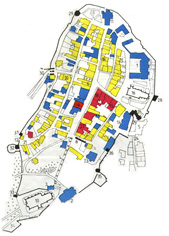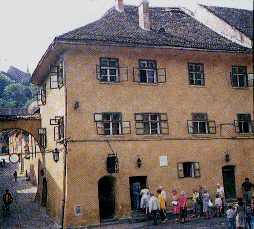  SIGHISOARA
Sighisoara is situated in the center of Romania at 121 km (75 mi) northwest of Brasov, 328 km (154 mi) northwest of Bucharest. Long before you reach this enchating place, you can see Sighisoara's towers and spires from a distance. Towering above the modern town is a medieval citadel that must be among the loveliest and least spoiled in Europe.
Walking up from the city center of Sighisoara, one enters the citadel through the 60-meter-tall clock tower, which dates from the 14th century. The clock still works, complete with rotating painted wooden figures, one for each day of the week. The tower houses the town's History Museum, which includes some moving photographs of the 1989 revolution that led to the execution of dictator Nicolae Ceausescu and his wife, Elena.
From the wooden gallery at the top of the tower you can look out over the town with its terra-cotta roofs and painted houses. Opposite the clock tower is a small ocher-colored house where the father of Vlad Tepes, better known as Dracula, once lived. It is now a pleasant restaurant. Walking uphill form the home of Dracula's father, along narrow, cobbled streets lined with faded pink, green and ocher houses, you'll come to a covered staircase. This leads to a 14th-century Gothic church and a German cemetery.
In Eastern Europe Sighisoara is one of the few (and in Romania, the only) fortified towns which are still inhabited. Its aspect, characteristic for the German towns of the late Middle Ages, as well as the good positioning on the Târnava Mare river has led to the town being named the "Pearl of Transylvania".
First mention in documents of the town was made as early as 1280, but there is archeological evidence of successive settlements for over 4000 years. Dacian, Roman and earky Romanian dwelling places werw in this area. Nevertheless the town as it is known today was founded by German colonists.
Beginning with the second half of the 12th century German settlers were brought to Transylvania by the Hungarian kings. They founded many villages and towns among which Sighisoara is most outstanding.
An early settlement was most likely a village with a fortified refuge on the Castle Hill of today, it was destroyed by a Tatar invasion in 1241, rebuilt, and in 1280 documanted as Castrum Sex. Soon the Dominicans took interest in this place-in 1289 Schespurch (Scassburg) is indicated as seat of their monastery-and later the Franciscans.
The other German settlers to follow in the 14th century are mainly craftsmen and thus in 1367 Sighisoara is already known as town-Civitas de Segusvar. Under the threat of the Otoman invasions the town was fortified wall and towers were raised to sorround the whole town, about the year 1490.
The 15th and 16th century are the time of the town's great prosperity. The craftsmen, well-organized in guilds, and traders, taking advantage of the major commercial routes passing through the town were the agents of this progress. Thus, the number of the crafts (25) equal Sighisoara to the main German towns of the time, and trade contacts went as far as the Netherlands and Persia. This makes Sighisoara to be the first of the settlements in Transylvania to gain the status of a town in 1517, and even legal autonomy.
Besides having a history of their own, the townspeople of Sighisoara were involved in the major events concerning Transylvania and Romania. Thus they gave shelter (1431-1435) and support to Vlad Dracul in his attempt to get to the Romanian throne. It is one of his writings that the Romanian name of Sighisoara was first mentioned. Later the town supports the great Romanian Prince Viteazul (the Brave) to conquer Transylvania. The citizens of Sighisoara were also involved in the Peasant's Rising of 1514, and in 1849 they are witness of the Hungarian revolutionary army's defeatt in the battle of Albesti, a place in the neighbourhood of the town.
The Architecture of the City is remarkable:
The town itself had several times been besieged, for tha last time in 1704, but never taken in. There were other hardships that affected the citizens, recorded as "the worst" in the town's history: a flood (1777), an earthquake (1738), the plague (1709), causing the death of 1300 out of 3000 inhabitants, a fire (1676) destroying 3/4 of the houses, later rebuilt of brick and stone.
THE CASTLE
 | | Castle Map |
The houses, streets and market place inside the Castle bear the typical traces of a craftsmen's town. However, there are some houses which belonged to the rich patriciate, like the House with Antlers, the Venetian House (the Mayor's residence) and the Vlad Dracul House.
The two churchers-the Church on trop of the Hill (14th century) and the Monastery Church (15th century) were both builit in the Gothic style, to which barowue elements were added later. Local craftsmen, painters and sculptors as well as famous Local craftsmen, painters and sculptors as well as famous one ones coming from Konisberg, Salzburg, Boemia and Tirol have used their skill in building these churches.
The school, also built on top of the Castle Hill, was first documented in 1522, but is most likely older. Two centuries later the covered stairway with 176 steps was made. The fact that good education was given here is proved by the 95 students from Sighisoara reading at the Universities of Vienna and Cracovia between 1402 and 1520.
Parts of the defensive towers can still be seen. The wall and the towers were raised, repaired and defended by the craftsmen's gulds and still bear their names, like the Transmithes, Goldsmithes, Locksmithes, Tinners, Tanners, Ropers, Butchers. The most oustanding among there towers is certainly the past and became a symbol of the town's autonomy, a privilege few towns of these times could claim. Council was held here up to 1556 and it sheltered the town's history troughout the ages.
Most interesting are a surgery and a chemist's from the 17th century, the furniture of Maria Terezia's time and medieval weapons. Visitors also take much interest in the ancient alockwork as well as the figurines showing the days of the week.
The growing interest in legentds concerning the figure of Dracula has recently added to the town's fame, since the famous Romanian prince Vlad Tepes surnamed "Dracula" had some links to Sighisoara, Thus, his father, Vlad Dracul, was sheltered here for four years but most certainly some time before his last short reigning years, in Sighisoara. The house where they took accomodation is now named the Vlad Dracul house.
His strange fame it is because the legends arose from his qualities and action. There were the severe punishments retaliated ti his ennemies in a more tolarent area; his ennemies amplified his harshess and so did the books and films on vampieres beginning the 19th century.
Unfortunately Dracula has overshadowed the great names that made Sighisoara famous: the mayor Stephanus Mann, the historian Georgius Krauss, the chemist Andreas Bertram, the elergyman and man of letters Zaharia Boiu, the journalist Ilarie Chendi. If those personalities are noit as famous as prince Vlad Tepes-Dracula this is not, anyhow, Vlad Tepes's fault. Still the town's most famous sons are Michael Freiherr von Melas, son of the town's vicar and commander in chief of the Austrian army in the battle of Marengo, and Hermann Oberth, the man of science who passed from the School on top of the Castle Hill into the cosmos.
Owing to its location and history, simple architecture which has been preserved in spite of many changes, Sighisoara will remain one of the most remarkable places in Europe.
Dining and Lodging
Casa Vlad Dracul [below]. In a house where the father of Vlad Tepes, better known as Dracula, once lived, this pleasant bar and restaurant is the best place in town for a meal. On the first floor you can drink draft beer from a tankard and sit at wooden tables. Upstairs, you'll find a cozy restaurant with fittingly Gothic-style furniture that serves good soups and traditional Romanian dishes.

Steaua. This 19th-century hotel has seen better days. Though the lobby is shabby, the rooms are spacious and clean, and the staff is helpful. The restaurant serves traditional Romanian dishes and is reasonably priced.
Last update: 2002, July 4 BACK
|



